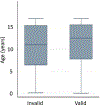T-SPOT.TB Performance in Routine Pediatric Practice in a Low TB Burden Setting
- PMID: 29140933
- PMCID: PMC12190735
- DOI: 10.1097/INF.0000000000001792
T-SPOT.TB Performance in Routine Pediatric Practice in a Low TB Burden Setting
Abstract
Background: The T-SPOT.TB, an interferon-gamma release assay, is an indirect test of Mycobacterium tuberculosis infection. Due to sparse and conflicting evidence, the use of interferon-gamma release assay is limited in young and HIV-infected children. We determined the prevalence of invalid, borderline, positive and negative results and associations with key demographic variables during routine pediatric use in a low tuberculosis burden setting.
Methods: For pediatric samples received at Oxford Diagnostic Laboratories between 2010 and 2015, the associations between initial test outcome and demographics were estimated by bivariate analysis and logistic regression.
Results: A total of 44,289 samples (median age 12.5 years; interquartile range 7.7-15.5), including 5057 samples (11.6%) from children under 5 years old, were received from 46 U.S. states, Washington, DC and Puerto Rico. A total of 592 samples (1.3%) could not be tested. T-SPOT.TB positivity was strongly correlated (r = 0.60; P < 0.0001) with state TB incidence. Compared with negative results, positive results were more likely in samples from older children (P < 0.0001), public health clinics (P < 0.0001) and rural locations (P = 0.005). Although infrequent (0.6%), invalid results were more common in samples collected at HIV clinics (odds ratio = 2.5, 95% confidence interval: 1.3-4.9) and from younger children (P = 0.03). These invalid results were more likely due to a robust nil (negative) control response rather than a weak mitogen (positive) control response.
Conclusions: The T-SPOT.TB test correlated strongly with well-recognized risk factors for tuberculosis infection and provided evaluable results in 98% of children. To optimize the impact of testing on clinical decision making and patient outcomes, local epidemiology and individual patient risk should be considered when incorporating IGRAs into pediatric guidelines.
Conflict of interest statement
The other authors have no conflicts of interest to disclose.
Figures


Similar articles
-
Accurate diagnosis of latent tuberculosis in children, people who are immunocompromised or at risk from immunosuppression and recent arrivals from countries with a high incidence of tuberculosis: systematic review and economic evaluation.Health Technol Assess. 2016 May;20(38):1-678. doi: 10.3310/hta20380. Health Technol Assess. 2016. PMID: 27220068 Free PMC article.
-
A systematic review of rapid diagnostic tests for the detection of tuberculosis infection.Health Technol Assess. 2007 Jan;11(3):1-196. doi: 10.3310/hta11030. Health Technol Assess. 2007. PMID: 17266837
-
Interferon-γ release assays for the diagnosis of tuberculosis and tuberculosis infection in HIV-infected adults: a systematic review and meta-analysis.PLoS One. 2012;7(3):e32482. doi: 10.1371/journal.pone.0032482. Epub 2012 Mar 5. PLoS One. 2012. PMID: 22403663 Free PMC article.
-
Comparing interferon-gamma release assays with tuberculin skin test for identifying latent tuberculosis infection that progresses to active tuberculosis: systematic review and meta-analysis.BMC Infect Dis. 2017 Mar 9;17(1):200. doi: 10.1186/s12879-017-2301-4. BMC Infect Dis. 2017. PMID: 28274215 Free PMC article.
-
Xpert® MTB/RIF assay for extrapulmonary tuberculosis and rifampicin resistance.Cochrane Database Syst Rev. 2018 Aug 27;8(8):CD012768. doi: 10.1002/14651858.CD012768.pub2. Cochrane Database Syst Rev. 2018. Update in: Cochrane Database Syst Rev. 2021 Jan 15;1:CD012768. doi: 10.1002/14651858.CD012768.pub3. PMID: 30148542 Free PMC article. Updated.
Cited by
-
Risk Factors for Indeterminate Interferon-Gamma Release Assay for the Diagnosis of Tuberculosis in Children-A Systematic Review and Meta-Analysis.Front Pediatr. 2019 May 29;7:208. doi: 10.3389/fped.2019.00208. eCollection 2019. Front Pediatr. 2019. PMID: 31192175 Free PMC article.
-
Evolution of tuberculosis diagnostics: From molecular strategies to nanodiagnostics.Tuberculosis (Edinb). 2023 May;140:102340. doi: 10.1016/j.tube.2023.102340. Epub 2023 Apr 5. Tuberculosis (Edinb). 2023. PMID: 37031646 Free PMC article. Review.
-
Low secondary attack rate after prolonged exposure to sputum smear positive miliary tuberculosis in a neonatal unit.Antimicrob Resist Infect Control. 2022 Dec 5;11(1):148. doi: 10.1186/s13756-022-01179-8. Antimicrob Resist Infect Control. 2022. PMID: 36471416 Free PMC article.
-
Heterogenous Immune Response to TB is Not a False Negative.Am J Trop Med Hyg. 2020 Mar;102(3):699. doi: 10.4269/ajtmh.19-0896b. Am J Trop Med Hyg. 2020. PMID: 32519645 Free PMC article. No abstract available.
-
Factors Influencing the Indeterminate Results in a T-SPOT.TB test: A Matched Case-control Study.Intern Med. 2023 Nov 15;62(22):3321-3326. doi: 10.2169/internalmedicine.1006-22. Epub 2023 Mar 31. Intern Med. 2023. PMID: 37005270 Free PMC article.
References
-
- WHO. Global Tuberculosis Report, 2016. Geneva, Switzerland: WHO; 2016. Contract No.: WHO/HTM/TB/2016.13.
-
- Dodd PJ, Sismanidis C, Seddon JA. Global burden of drug-resistant tuberculosis in children: a mathematical modelling study. Lancet Infect Dis. 2016;16:1193–1201. - PubMed
-
- Uplekar M, Weil D, Lonnroth K, et al. ; for WHO’s Global TB Programme. WHO’s new end TB strategy. Lancet. 2015;385:1799–1801. - PubMed
-
- Mack U, Migliori GB, Sester M, et al. ; C. Lange; TBNET. LTBI: latent tuberculosis infection or lasting immune responses to M. tuberculosis? A TBNET consensus statement. Eur Respir J. 2009;33:956–973. - PubMed
-
- Andersen P, Munk ME, Pollock JM, et al. Specific immune-based diagnosis of tuberculosis. Lancet. 2000;356:1099–1104. - PubMed
Publication types
MeSH terms
Grants and funding
LinkOut - more resources
Full Text Sources
Other Literature Sources
Medical

